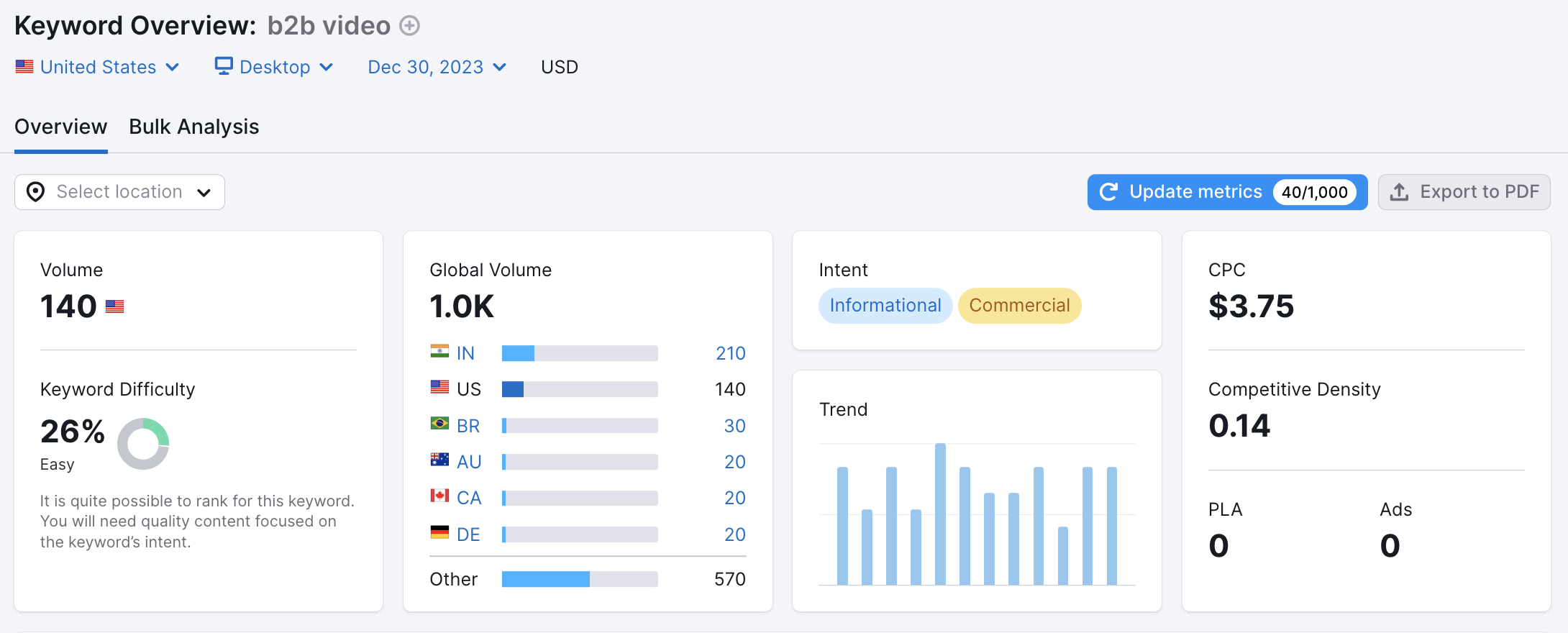Good SEO marketing is all about getting your brand’s valuable content in front of people—to position your brand as a helpful resource and, by default, a better option than your competitors. With the right keyword strategy, you can increase your SEO rankings, site traffic, brand visibility, and site authority—all of which help ensure that the people who want or need your type of product or service can actually find you on the Internet (ideally before they find your competitors).
That said, good SEO doesn’t just happen. As the Internet becomes more crowded (especially with the proliferation of AI-generated content), you need to thoughtfully craft content around the right keywords to get the best rankings. But how do you figure out the right keyword strategy? Today, we’re breaking it all down for you.

What Is a Keyword Strategy?
A keyword strategy is the process of researching and identifying the most relevant keywords for your brand, then crafting content to rank for those keywords.
Now, choosing the right keywords may seem like a simple task, but it can be tricky.
- Some marketers go too broad, using high-level keywords that get a lot of traffic but very few leads.
- Some go too niche, targeting obscure keywords that no one ever really searches for.
- Others simply guess which keywords they should target, or take the spray-and-pray approach and go for them all.
In each case, the results are less than spectacular. (BTW, if you fall into any of these camps, don’t beat yourself up too much. We’ve committed all of these sins at some point over the last decade.)
But remember: SEO is not just about getting your content in front of people. You want to get it in front of the right kind of people, those who will find value in what you have to say and may one day need your products or services. That’s why you need to do the legwork to identify the right keywords for your brand goals.
What Are the Main Types of Keywords?
First things first, when choosing the right keywords, you need to think about the user intent: why are they searching for that particular keyword? In general, there are four main categories of intent:
- Informational: People are looking for information about a subject.
- Navigational: People are looking for a specific website.
- Commercial: People are searching for information about brands, products, services, etc.
- Transactional: People are looking to purchase or take an action (e.g., buy or subscribe).
As you craft your keyword strategy, you want to focus on your audience’s intent and how you can serve it. (Luckily, many SEO tools can identify what type of intent a user has when they search for a specific keyword, so you don’t have to guess.)
What Is the Best Mix of Keywords for Marketers?
To attract and convert the right audience, you want to curate a solid list of keywords that are relevant and attainable. Ultimately, you want to source these keywords from three core categories.
- Informational keywords your audience in interested in: Building your content strategy around these topic clusters is the best way to create a healthy mix of content that answers the big, evergreen questions that your audience will always want to know about (specifically in relation to your product, service, or industry).
- Commercial intent keywords relevant to your business: These are the specific keywords people are searching when they want to buy your type of product/service. Note: One of the biggest mistakes marketers make is assuming that the terms they use for their product/service are the same ones their audience uses. This is why it’s important to do proper research.
- Keywords your competitors rank for: These are the keywords that your competitors have targeted, so you want to not only target them but ideally surpass them. This is always helpful to look at because they may be targeting keywords you would not have thought to consider.
By curating the right mix, you can ensure your brand is a strong SEO competitor that will continue to climb the ranks—literally. That said, not every keyword will be advantageous to target. As you’re doing your research, you will also want to consider:
- Longtail keywords: These are longer variations of keywords (e.g., “brand campaign” vs. “beauty brand campaign examples”). While longtail keywords tend to have less search volume, they are more specific to your business and, ideally, have lower competition.
- Search volume: This is how popular the word is. The more people are searching for the keyword, the higher the volume. You want something with a decent search volume (but not so high it will be impossible to rank). In fact, low-volume keywords can be advantageous in that they’re low-hanging fruit—fewer people are searching for them and there is less competition to rank for them.
- Keyword difficulty: This is how difficult it is to rank for this word (due to its popularity). As Rand Fishkin of Moz points out, “I personally think of [Keyword Difficulty] scores in the 20-35 range as being quite low, 36-50 in the middle, 51-65 pretty tough, and 66-80 as very difficult.”
- Relevancy: The more relevant the keyword, the better it will be for your brand (e.g., “ice cream” vs. “gluten-free vanilla ice cream”).
Although this may seem like a lot of information, it’s crucial to keep in mind if you want to craft a truly effective keyword strategy.
How to Build a Strong Keyword Strategy
We know how much the right keyword strategy can improve your marketing. (In fact, we increased leads 78% in six months when we revised ours.) So we’re here to guide you through the process. Follow these simple steps to source and curate the best keywords for your brand and you’ll be on page one in no time.
Note: To do this, you’ll need access to keyword tools like Google Keyword Planner, Moz, Semrush, etc. These tools will help you research keywords, assess how difficult it will be to rank, and offer you additional suggestions you may not have thought of.
STEP 1: Know your goals.
If you’ve created a comprehensive content strategy, you should know exactly what you’re trying to achieve. (If you haven’t, follow our guide to create a content strategy.) Your keyword strategy will support your larger business goals. So, for example, if you’re trying to attract more business for a specific product or service you offer, you’ll want to prioritize keywords related to that subject.
STEP 2: Examine your personas.
In some ways, a keyword strategy is reverse-engineering your buyer’s journey, helping you identify:
- Who you’re trying to reach
- What information they’re interested in
- What search terms they use to find the information they want
The “who” is crucial, which is why you need to document clear personas that detail the demographic and psychographic attributes of the people you’re trying to reach. (Here’s how to create personas if you don’t have them already.)
STEP 3: Research the keywords your audience in interested in.
Start by compiling a list of all the keywords, subjects, categories, or themes that your audience may be interested in. You probably already have a good idea, but it’s important to look at things from their perspective.
- Talk to your key stakeholders, especially your sales team. They know what customers are thinking about, looking for, and curious to know.
- Dig into Google Analytics to identify what terms people are using to find you now. (Check your traffic sources and related keywords.)
- Go to AnswerThePublic and type in any subject. It will generate a list of questions and related topics that people are asking about.
You’ll narrow down the list later, but first you want to identify every potential keyword under your umbrella.
STEP 4: Find keywords with commercial intent—and moderate keyword difficulty.
Many SEO tools can denote a search term’s intent. Look up the main subjects that your audience is interested, then filter by:
- Search intent: Filter intent by “commercial” and “transactional.” These are the keywords people who are looking to buy or ready to buy are using.
- Keyword difficulty: Set your KD to 50% or less. This helps you identify the keywords that you will likely be able to rank for.
- Volume: Filter keywords that have a search volume of at least 100 per month—this ensures people are actually searching these keywords.
Together, these filters will help you find the low-hanging, easy-to-rank-for keywords that align with your goals and match what your audience is actually looking for throughout the buyer journey.
STEP 5: Look at keywords your competitors rank for.
Your SEO tool will likely offer the ability to compare your brand to your competitors to see what terms they’re ranking for. (If not, see Wordstream’s roundup of the best SEO competitor tools.)
This exercise is incredibly helpful in that it allows you to find keywords you may have not thought to target. Additionally, in the course of doing all of this research, you may also find gaps. For example, you might find a low-volume search term that your competitors aren’t ranking for. That’s an easy win that can help you gain more visibility quickly.
STEP 6: Refine your list.
Now it’s time to review your full list of potential keywords and prioritize which words you should target first. This may require more detailed research into things like search volume and keyword difficulty, but you generally want to identify the highest-priority keywords. As you review and narrow down your list, consider:
- Which keywords are most relevant to your audience?
- Which keywords do you want to establish your expertise in?
- Which keywords can you realistically rank for?
- Which keywords do you currently rank well for? (You may want to target related longtail keywords in these areas.)
- Which topics do your competitors not talk about?
Remember, too, that keyword strategy is half art and half science. Depending on your product or service, you may find your more generic keywords to be decent options. However, if they are too broad or too difficult to rank for, you may want to explore more specific terms. Luckily, your keyword tool will offer related keyword suggestions.
For example, we followed this exact process to craft our own keyword strategy. One area we wanted to focus on was video marketing, as that is a core service we provide. However, as we researched the subject, we realized the term “video marketing” is already a popular keyword (and thus difficult to rank for). But as we dove into longtail keywords and applied various filters for search volume, keyword density, etc., we found the term “B2B video” to be a great candidate.
- It was relevant to our B2B-centric audience.
- It had both commercial and informational intent.
- It had a search volume above 100 (140).
- It had a low Keyword Difficulty score (26%).
- Some of our biggest competitors weren’t ranking for the term.

To rank for this word, we brainstormed ideas we knew would resonate with our audience. Having previously polled our email subscribers about their preferred type of content, we knew our audience particularly enjoyed marketing example roundups. So, we created the post “15 B2B Video Examples That Are Anything But Boring,” which made it to the #1 spot for “B2B video,” as well as related terms like “B2B marketing videos” and “b2b video ideas.” Although tedious, doing the right keyword research helped us identify a previously missed opportunity and reach the exact audience we wanted.
STEP 7: Put your keyword strategy to work.
Once you have your list ready, it’s time to hit the ground running to grab all those sweet, sweet rankings.
- Generate fresh content. Now you can brainstorm fresh content ideas to capture your audience’s attention. Again, think about the posts that have historically resonated with your audience, or what they might find most valuable. If you’re lacking inspiration, here are 30 prompts to get your creative ideas flowing.
- Optimize old content. One of the easiest ways to improve your rankings is to refresh your existing content. Try alt keywords, add more relevant info to the post, refresh the visuals, and make sure to optimize everything appropriately: headers, subheads, image titles, body copy, etc. Luckily, tools like Yoast will help you optimize your content, flag what’s missing, and offer suggestions to improve SEO. We also find it helpful to create an optimization checklist to make sure you don’t forget anything. (For more tips on optimizing for SEO, find out how to optimize your infographics and blog.)
- Track, measure, and tweak. Remember: Your keyword strategy will evolve with your content strategy, so don’t get discouraged if you aren’t seeing the results you’d like. The more you track, the more you’ll identify ways to tweak, iterate, and improve. You may find you need to target a keyword with a lower or higher search volume. Or you may find a different longtail keyword to be much higher converting than you realized. We also suggest revisiting your strategy every quarter to make sure it still works for you.
Of course, if you’re feeling stuck and need a little extra help with your keyword or content strategy, it’s always helpful to find a savvy partner to help you through it. If you need a little extra boost, find out what it’s like to work with us (or reach out directly). We’d love to help you become your own SEO success story.





wow! what a great post. And I am very excited to read coming next post like this information is very helpful.